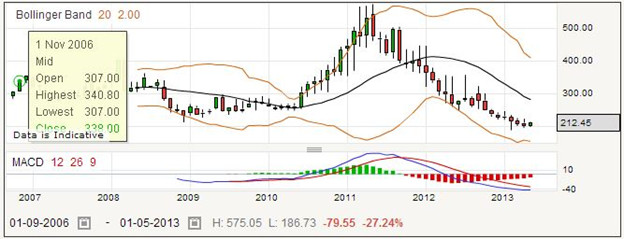As an agricultural commodity, the first thought when trading on coffee is that the price is influenced by the weather. There are many other factors affecting the movement of the price, however. Here is the chart for ETC (exchange traded commodity) coffee: –
You can see that the price has varied enormously over the years. The major countries for coffee production are Brazil, Vietnam, Columbia, and Indonesia, with Brazil by far the largest producer, generating about one third of the world supply. Brazil and Columbia tend to concentrate on the Arabica coffee bean, which is generally regarded as being a higher quality than the alternative Robusta.
It therefore makes sense to watch the weather in Brazil, which from time to time would suffer from a winter freeze in the middle of the year (as Brazil is in the southern hemisphere). However, recently the weather has improved and coupled with the producers moving their operations further north towards the equator, freezes are seldom expected nowadays.
The crop is harvested in May or June, and therefore the price often goes down after this because of the abundance of supply. However, on a trading timescale this and weather factors are usually not significant influences.
The production of coffee has become a major factor for some developing countries. For instance Vietnam which mainly grows the Robusta bean has increased its output so that it is second only to Brazil. And in Ethiopia, coffee accounts for more than half of its exports. This means that the traditional coffee producing countries are increasingly threatened, particularly as technology has developed to allow the cheaper Robusta bean to be more palatable than it was.
When trading on coffee, it is a good idea to keep an eye on the MACD which tends to be an effective indication of trader sentiment.
Coffee Rolling Daily
With IG Index, the rolling daily bet for coffee is on the exchange traded commodity (ETC) coffee fund price, and the current quote is 211.92 – 212.98. As with any other trading, technical analysis can reveal trader sentiment, and allow you to anticipate short-term price movements. Say you decide from your study that the price of coffee is going up, you could place a long spread bet, buying at 212.98 and staking £4 per point.
If this position works out for you, and the price goes up, you may choose to close your bet and cash in when the quote reaches 325.92 – 326.98. Your gain in points would be 325.92 minus 212.98, which is 112.94 points. You chose to wager £4 per point, so this works out to a total gain of £451.76. With a long bet on the daily price, your account may have been charged interest each evening when the bet is rolled over, but it is not usually a significant amount on a short term bet.
If you got it wrong, and the price drops after you place your long spread bet, then you may choose to close your position and accept your losses when the quote goes down to 154.92 – 155.98. The closing price in this case would be 154.92, the selling price. Taking 154.92 away from 212.98, the opening price, you would have lost 58.06 points. 58.06 times the £4 stake amounts to a loss of £232.24.
Many spread betters decide to use a stop loss order to help them control their losses. The stop loss order works even if you are not watching the markets, as your spread betting provider must close the bet for you if it reaches a certain losing level that you set. In this case, perhaps a stop loss order would trigger and sell when the quote was 177.72 – 178.78. 212.98 less 177.72 is 35.26 points, and this works out to a loss of £141.04.
Coffee Futures
With IG Index you may place a futures style bet on ETC coffee, expiring in a couple of months. This short-term futures style bet is currently priced at 211.77 – 213.47. You may choose to take a short position on coffee, selling at 211.77 and staking £2.50 per point. Bear in mind that you should always analyse the chart in detail, so that you have a good reason for the direction of your bet.
If your analysis turns out, you might find that the quote goes down to 130.77 – 132.47, and at this point decide to close your bet and collect your profit. Your short bet closed at the higher or buying price of 132.47, so that means you made 211.77 minus 132.47 points, which works out to 79.3 points. For your wager of £2.50 per point, your profit is £198.25.
However carefully you analyse the charts, you will have your share of losses. It is by keeping your losses small that you aim to come out on top overall. Say the price went up to 238.77 – 240.47, and you decided to close and accept the loss. Your short bet was placed at 211.77. The closing price was 240.47. That means you have lost 28.7 points, and multiplying this by your stake of £2.50 your losses amount to £71.75.
One spread betting tool which is available to you is the stop loss order, which you place with your spread betting provider when you take out your initial bet. It requires your dealer to close a losing trade if it reaches a level you set, and saves you having to watch the market all the time. In this case a stoploss order might have closed your losing bet when the price went up to 227.97 – 229.67. In this case you would have lost 229.67 minus 211.77 points, or 17.9 points. Multiplying this by your wager your total losses amount to £44.75.
